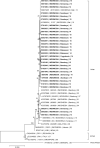Chikungunya in Indonesia: Epidemiology and diagnostic challenges
- PMID: 32479497
- PMCID: PMC7289446
- DOI: 10.1371/journal.pntd.0008355
Chikungunya in Indonesia: Epidemiology and diagnostic challenges
Abstract
Background: Chikungunya virus (CHIKV) is often overlooked as an etiology of fever in tropical and sub-tropical regions. Lack of diagnostic testing capacity in these areas combined with co-circulation of clinically similar pathogens such as dengue virus (DENV), hinders CHIKV diagnosis. To better address CHIKV in Indonesia, an improved understanding of epidemiology, clinical presentation, and diagnostic approaches is needed.
Methodology/principal findings: Acutely hospitalized febrile patients ≥1-year-old were enrolled in a multi-site observational cohort study conducted in Indonesia from 2013 to 2016. Demographic and clinical data were collected at enrollment; blood specimens were collected at enrollment, once during days 14 to 28, and three months after enrollment. Plasma samples negative for DENV by serology and/or molecular assays were screened for evidence of acute CHIKV infection (ACI) by serology and molecular assays. To address the co-infection of DENV and CHIKV, DENV cases were selected randomly to be screened for evidence of ACI. ACI was confirmed in 40/1,089 (3.7%) screened subjects, all of whom were DENV negative. All 40 cases initially received other diagnoses, most commonly dengue fever, typhoid fever, and leptospirosis. ACI was found at five of the seven study cities, though evidence of prior CHIKV exposure was observed in 25.2% to 45.9% of subjects across sites. All subjects were assessed during hospitalization as mildly or moderately ill, consistent with the Asian genotype of CHIKV. Subjects with ACI had clinical presentations that overlapped with other common syndromes, atypical manifestations of disease, or persistent or false-positive IgM against Salmonella Typhi. Two of the 40 cases were possibly secondary ACI.
Conclusions/significance: CHIKV remains an underdiagnosed acute febrile illness in Indonesia. Public health measures should support development of CHIKV diagnostic capacity. Improved access to point-of-care diagnostic tests and clinical training on presentations of ACI will facilitate appropriate case management such as avoiding unneccessary treatments or antibiotics, early response to control mosquito population and eventually reducing disease transmission.
Conflict of interest statement
The authors have declared that no competing interests exist.
Figures




Similar articles
-
Comparison of clinical presentation and out-comes of Chikungunya and Dengue virus infections in patients with acute undifferentiated febrile illness from the Sindh region of Pakistan.PLoS Negl Trop Dis. 2020 Mar 23;14(3):e0008086. doi: 10.1371/journal.pntd.0008086. eCollection 2020 Mar. PLoS Negl Trop Dis. 2020. PMID: 32203509 Free PMC article.
-
Epidemiological trends and molecular dynamics of dengue, chikungunya virus infection, coinfection, and other undifferentiated fever during 2015-2016 in Odisha, India.J Med Virol. 2019 Feb;91(2):163-170. doi: 10.1002/jmv.25307. Epub 2018 Sep 24. J Med Virol. 2019. PMID: 30192396
-
Co-Circulation of Chikungunya and Multiple DENV Serotypes and Genotypes, Western Indonesia 2015-2016.Viruses. 2022 Jan 6;14(1):99. doi: 10.3390/v14010099. Viruses. 2022. PMID: 35062303 Free PMC article.
-
Co-circulation and simultaneous co-infection of dengue, chikungunya, and zika viruses in patients with febrile syndrome at the Colombian-Venezuelan border.BMC Infect Dis. 2018 Jan 30;18(1):61. doi: 10.1186/s12879-018-2976-1. BMC Infect Dis. 2018. PMID: 29382300 Free PMC article.
-
Evaluating the burden and transmission dynamics of chikungunya virus infections in the Eastern Mediterranean Region: a systematic review and meta-analysis.Eur J Public Health. 2025 Jan 1;35(Supplement_1):i27-i34. doi: 10.1093/eurpub/ckae165. Eur J Public Health. 2025. PMID: 39801330 Free PMC article.
Cited by
-
Serological and molecular evidence of chikungunya virus infection among febrile outpatients seeking healthcare in Northern Malawi.Infect Ecol Epidemiol. 2023 Jun 27;13(1):2229573. doi: 10.1080/20008686.2023.2229573. eCollection 2023. Infect Ecol Epidemiol. 2023. PMID: 37387776 Free PMC article.
-
Diagnostic challenges of arboviral infections and dengue virus serotype distribution in febrile patients in East Java, Indonesia.IJID Reg. 2024 Dec 4;14:100512. doi: 10.1016/j.ijregi.2024.100512. eCollection 2025 Mar. IJID Reg. 2024. PMID: 39850333 Free PMC article.
-
An investig-ation into the epidemiology of chikungunya virus across neglected regions of Indonesia.PLoS Negl Trop Dis. 2020 Dec 21;14(12):e0008934. doi: 10.1371/journal.pntd.0008934. eCollection 2020 Dec. PLoS Negl Trop Dis. 2020. PMID: 33347450 Free PMC article.
-
Clinical and epidemiologic evaluation of a 2020 chikungunya outbreak in Cambodia.BMC Infect Dis. 2022 Dec 17;22(1):949. doi: 10.1186/s12879-022-07936-9. BMC Infect Dis. 2022. PMID: 36526991 Free PMC article.
-
Seroprevalence of Chikungunya in an Asymptomatic Adult Population in North and South Sulawesi, Indonesia.Am J Trop Med Hyg. 2022 Dec 19;108(2):359-362. doi: 10.4269/ajtmh.22-0328. Print 2023 Feb 1. Am J Trop Med Hyg. 2022. PMID: 36535254 Free PMC article.
References
Publication types
MeSH terms
Substances
Grants and funding
LinkOut - more resources
Full Text Sources
Medical

